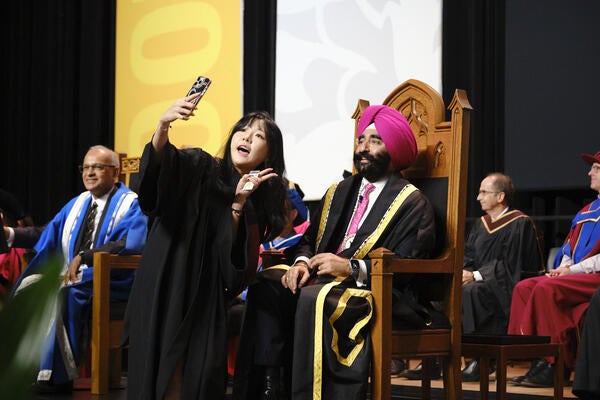
Bringing science fiction home
“You don’t want it to become like Times Square in your home: ” Computer science researcher brings an artist’s eye to the technology that will surround us.

“You don’t want it to become like Times Square in your home: ” Computer science researcher brings an artist’s eye to the technology that will surround us.
By Beth Gallagher Communications and Public AffairsDaniel Vogel is creating a future where the walls in your home will speak to you. He envisions digital wallpaper that will let you know that you’ve left a burner on, for example, or that your e-mails are piling up.

The ceiling might reveal the temperature outside, then - with a subtle movement of your finger – it will communicate tomorrow’s weather. You will be able to buy paint, he hopes, roll it on your wall, and embedded pixels will self-organize to create a large interactive display.
“I really believe that eventually computing displays will be on everything – walls, floors and ceilings,” says Vogel, a recipient of a prestigious Banting postdoctoral fellowship awarded annually to top postdoctoral researchers. Vogel, who works in the University of Waterloo’s Human Computer Interaction Lab will join the David R. Cheriton School of Computer Science as a professor in May.
Whole body and large computers
As a computer scientist at the forefront of research into whole body interaction with large computing displays, Vogel is bringing what used to be science fiction into the real world. As a professional artist, he’s uniquely qualified to balance the power of computing with the aesthetics of design.
It’s easy to imagine, says Vogel, a dystopian world of large computers not only surrounding us but also overwhelming us. “I think it’s really important to think about these design issues because you don’t want it to become like (New York City’s) Times Square inside your home,” he says.
Art as science
Currently, Vogel is enjoying his first solo exhibit at the Owen’s Art Gallery at Mount Allison University in New Brunswick. The exhibit, which runs until April 28, presents two large-scale digital artworks. Siftor allows gallery visitors to interact with a wall-sized computer display of thousands of works of art in the Owen collection. The other display, called My Name is Owen, is a window projection of pseudo-random text from the gallery’s own website.
Siftor also doubles as a computer science experiment as Vogel gathers data on how gallery visitors interact with the very large display. “It’s a really nice pairing of science and art,” he says. The data will be used to explore emerging questions in the dynamic field of human-computer interaction.
For Vogel, it’s all about subtlety – computing displays communicating information by a subtle change in colour, for example. He says, people should be able to “talk back” using subtle movements that are very different from the jumping and kicking movements used with computer games like Xbox Kinect.
“I think I can make a difference,” says Vogel. “I can make the future a little more hospitable and comfortable…by embedding technology in a very subtle way into our environment.”

Read more
Waterloo welcomes 2,800 new graduates to its alumni club and celebrates their bold new journeys

Read more
From co-op to community, grads offer insights and inspiration for the next generation of students

Read more
Meet five exceptional Waterloo graduate students crossing the convocation stage as Class of 2025 valedictorians
The University of Waterloo acknowledges that much of our work takes place on the traditional territory of the Neutral, Anishinaabeg, and Haudenosaunee peoples. Our main campus is situated on the Haldimand Tract, the land granted to the Six Nations that includes six miles on each side of the Grand River. Our active work toward reconciliation takes place across our campuses through research, learning, teaching, and community building, and is co-ordinated within the Office of Indigenous Relations.